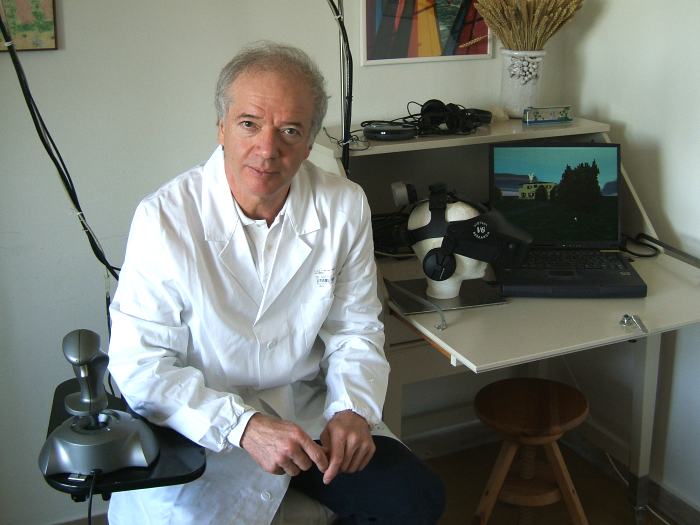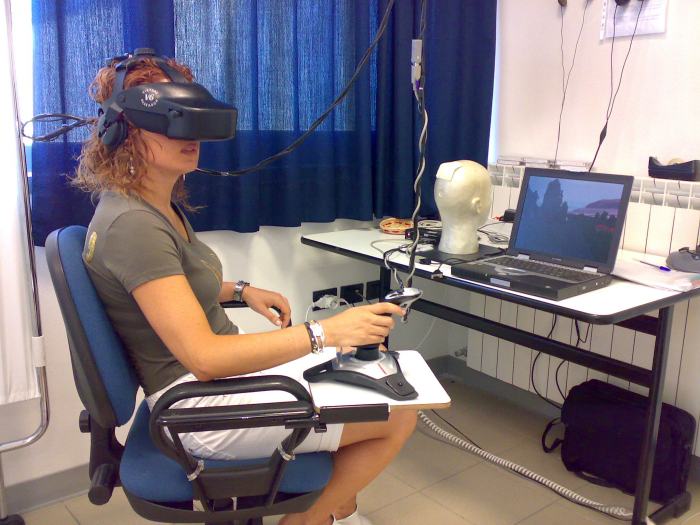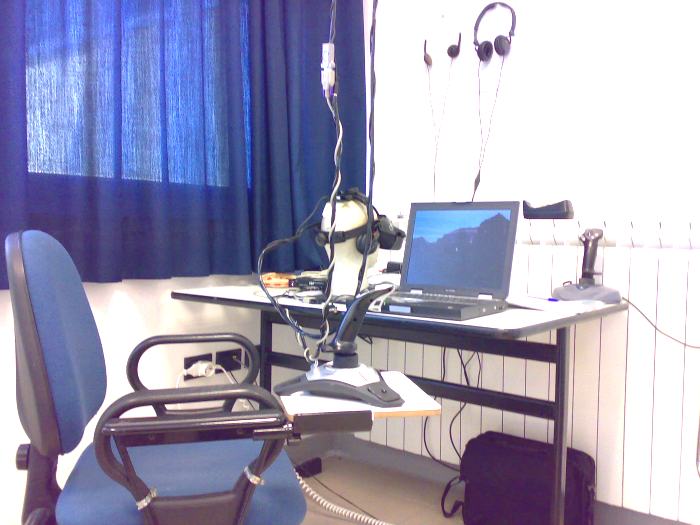What is Virtual Reality?
Gabriele Optale 
Virtual Reality (VR) is as a new technology which alters the way in which individuals inter-react with a computer. It is a mental experience capable of making the subject believe that he is 'present' in the scene in the virtual world. Interaction with the scene is achieved using a joystick and through wearing a helmet (the VR world is projected onto the inside of this helmet). When the subject moves the joystick and his head, according to his own wishes and exactly as if the he were moving his own head and legs in the real world, the subject has the sensation of moving in a virtual world but with the feeling that he is not being observed. Interaction with the Virtual World is, in our system, achieved by the wearing of a helmet (in which is projected the Virtual World). Movement within the world is obtained using a joystick. During the procedure, the patient is comfortably seated in a swivel-chair and is thus free to move according to his wishes. 
This definition of Virtual Reality might seem to be self-contradictory. In reality, however, the concept of VR is intimately connected with the concept of 'immersion' in that when we are immersed in a VR world our senses react to and with that world. This creates (as a best-case scenario) a state of maximum realism. Another basic concept is navigation: in other words the freedom to move about freely within a virtual space. The ability to navigate, to interact, greatly helps this sensation of 'immersion' and focused attention. The very first head-mounted display helmet was devised in the 1961. In 1965, Ivan Sutherland (through the creation of an interactive interface) was able to use this helmet for NASA flight simulations. Without doubt, the helmet is the most recognisable accessory and the most important in the control of the two principal senses: sight and hearing. This is achieved through electrical circuitry which, through sensors, can receive information. The subject who wears the helmet is no longer simply a passive spectator, watching things happen on a screen: he is an active participant with a real sense of being involved in what is happening, regardless of the fact that the objects he sees and the spaces in which he moves exist only in a computer memory and in the mind of the subject himself. 
Objectives The main fields in which VR is applied are motor and cognitive rehabilitation, therapy for certain phobias and in training. Another field in which this type of therapy is beginning to be used is in the treatment of sexual dysfunctions. In this field, VR forms a part of a therapeutic protocol according to a precisely calibrated scheme of ontogenetic development with the goal of successfully creating a male/female sexual identity which fulfils the needs of type, role and sexual orientation. The therapeutic cycle consists of 12 sessions of psychodynamic psychotherapy over a period of six months: initially every week then gradually at less frequent intervals. This cycle is integrates with some sessions with the partner. The European Community (EU) has financed several research projects in this area. Dr. Gabriele Optale coordinated a part of this projects in the treatment of male sexual dysfunctions, in which as well as the clinical use of VR is envisaged. Another field in which VR can be applied is memory impairment in the elderly (confirmed by clinical and neurological testing), at times associated with other cognitive dysfunctions (orientation, attention-span, language-skills, mathematical skills) in the opening stages. This has already been tested on members of the AUSER Association 'Stella d'Argento' of Marghera (Venice) and on residents of the " Anni Sereni" rest-care home in Scorzč (Venice). Volunteers (having given informed consent) could undergo tests to evaluate their cognitive capacities/abilities and, thereafter, we could propose to those who showed evidence of cognitive deficit the cycle of "Memory Training" using VR. This project and this outline proposal conform to the standards set down by the WHO which open up health care to the field of these suffering from cognitive dysfunction so that those who suffer can be allowed to live active lives fulfilling their potential in the best way possible. Present and Future Applications It is clear, of course, that this therapy's ability to affect deterioriation in the individual's potential, through its use of high-technology alongside presently available pharmaceuticals, in cases of particularly debilitating cognitive dysfunction and closely linked to the general physical ageing of the population, could find future application within the National Health structure. As far as the application of VR in the field of sexual dysfunction is concerned, this therapeutic cycle using VR does not preclude the use of pharmacological therapies which may be a useful initial tool when the patient requests/wants quick results. In cases of sexual dysfunction of purely psychological origins or of mixed origins (psychological and organic), the use of the VR therapy alongside urologist/andrologist or gynaecologist-prescribed pharmaceuticals, could also reduce the number of cases who 'drop out' of pharmaceutical therapy (i.e. who do not complete a course of prescribed therapy). It could also lessen the possible risk of pharmacological 'dependence' on drugs which are not strictly necessary but which are habitually used to achieve a consistent (yet artificial) sexual performance. |
| dal 14/01/2011 |